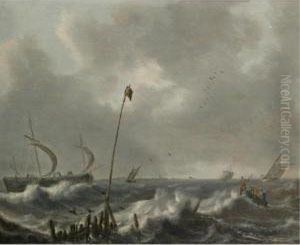Denys Waterloo Paintings
Denys van Alsloot, known as Denys Waterloo, was a Flemish painter, draughtsman, and etcher born in 1610. His contributions to art are often associated with landscape painting, a genre in which he excelled, depicting the natural beauty of his native land with a unique blend of realism and romanticism. Waterloo's works are characterized by their meticulous attention to detail, rich color palette, and the serene atmospheres he managed to convey through his depictions of forests, rivers, and rural scenes.
Waterloo received his initial art training in the vibrant cultural environment of Brussels, which was a significant center for art and commerce in the 17th century. Although not much is documented about his early life and training, it is believed that he was influenced by the works of other Flemish and Dutch landscape painters of the time. His style shows a particular affinity with the works of contemporaries such as Jacob van Ruisdael and Meindert Hobbema, emphasizing the dramatic play of light and shadow, as well as a keen observation of nature.
Throughout his career, Denys Waterloo enjoyed considerable success and recognition. He became known not only for his paintings but also for his skill as an etcher. His etchings, like his paintings, often featured landscapes but were also remarkable for their detail and the use of light and shadow, showcasing his versatility as an artist. Waterloo's landscapes were not just mere representations of nature; they were imbued with a sense of emotion and mood, reflecting the artist's response to the natural world around him.
Denys Waterloo's contribution to the art world extended beyond his lifetime, influencing the next generation of landscape painters. His works were collected and admired by art connoisseurs across Europe, helping to spread his reputation. Despite the passage of time, Waterloo's art remains a testament to the enduring beauty and complexity of the natural landscape, capturing the essence of the Flemish countryside with a timeless quality. He passed away in 1690, leaving behind a legacy that continues to be celebrated for its artistic merit and historical significance.
